AUDI Q5 2015 Owners Manual
Manufacturer: AUDI, Model Year: 2015, Model line: Q5, Model: AUDI Q5 2015Pages: 302, PDF Size: 75.01 MB
Page 171 of 302
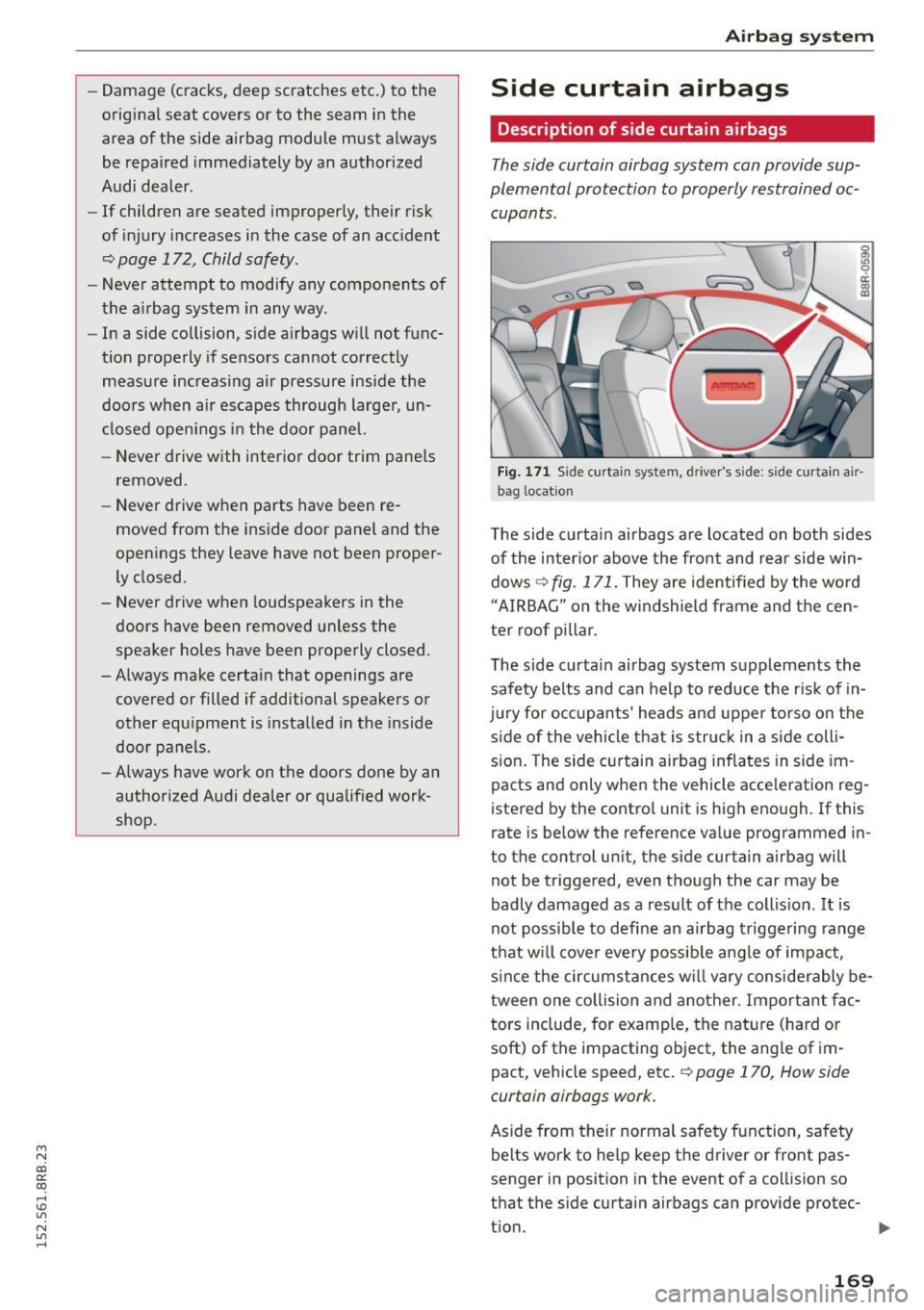
M N
co ~ co
rl I.O
"' N
"' rl
-Damage (cracks, deep scratches etc .) to the
original seat covers or to the seam in the
area of the side airbag module must always
be repaired immediately by an authorized
Audi dealer .
-If children are seated improperly, their risk
of injury increases in the case of an acc ident
¢ page 172, Child safety .
-Never attempt to modify any components of
the a irbag system in any way.
- In a side collision, s ide a irbags w ill not func
tion properly if sensors cannot correctly
measu re increasing air pressure inside the
doors when air escapes through larger, un
closed openings i n the door pane l.
- Never d rive with interior door trim pane ls
removed.
- Never drive when parts have been re
moved from the inside door panel and the
openings they leave have not been proper ly closed.
- Never drive when loudspeakers in the
doors have been removed unless the
speaker holes have been properly closed.
-Always make certain that openings are covered or filled if additional speakers or
other equ ipment is installed in the inside
door panels .
- Always have work on the doors done by an
authorized Audi dealer or qualified work
shop.
Ai rb ag system
Side curtain airbags
Description of side curtain airbags
The side curtain airbag system can provide sup
plemental protection to properly restrained oc
cupants.
,ft QOD'
8i 0 ci: a, m
F ig . 1 7 1 Side curtain system, d river 's s ide: s ide cu rta in a ir
bag locat io n
The side curtain airbags are located on both sides
of the inter ior above the front and rear side w in
dows ¢
fig. 171. They are identified by the word
"A IRBAG" on the w indshie ld frame and the cen
ter roof pi llar.
The side c urta in airbag system supplements the
safety belts and can help to reduce the ris k of in
j u ry for occ upants' heads and upper torso on the
s ide of the vehicle that is str uck in a s ide coll i
s io n. The side c urtain airbag inflates in side im
pacts and only when the vehicle acce leration reg
istered by the contro l unit is high enough. If this
rate is below the reference va lue programmed in
to the control un it, the side curtain airbag will
not be triggered, even though the car may be
badly damaged as a result of the collis ion . It is
not possible to define an airbag triggeri ng range
that w ill cove r every possible ang le of impact,
s ince the circumstances w ill vary considerably be
tween one collision and another. Important fac
tors include, for examp le, the nat ure (hard or
soft) of the impacting object, the angle of im
pact, vehicle speed, etc.
¢ page 170, How side
curtain airbags work.
Aside from their normal safety f unction, sa fety
belts work to he lp keep the driver or front pas
senger in position in the event of a collision so
that the side curtain airbags can provide protec-
t ion. ..,.
169
Page 172 of 302

Airbag system
The airbag system is not a substitute for your
safety belt. Rather, it is part of the overall occu
pant restraint system in your vehicle . Always re
member that the airbag system can only help to
protect you if you are wearing your safety belt
and wearing it prope rly. This is another reason
why you should always wear your safety belts, not just because the law requires you to do so
~ page 144, General information.
It is important to remember that while the side
curta in a irbag system is designed to help reduce
the likelihood of serious injuries, other injuries,
for example, swelling, bruising, and minor abra
sions can also be associated with these airbags.
Remember too, these airbags wi ll dep loy only
once and only in certain kinds of accidents -your
safety belts are always there to offer protection.
The side curtain airbag system basically
consists of:
-The electronic control modu le and externa l side
impact sensors
- The side curtain airbags above the front and
rear side w indows
- The airbag indicator light in the instrumen t
panel
The airbag system is monitored electron ically to
make certa in it is f uncti oning properly at all
times. Each time you turn on the ignition, the air
bag system indicator light wi ll come on for a few
seconds (self diagnostics).
The side curtain airbag is not activated:
-if the ignit ion is tu rned off,
- in s ide collisions when the acceleration meas-
ured by the sensor is too low,
- in rear-end collisions.
A WARNING
-Safety belts and the ai rbag system will on ly
provide protection when occupants are in
the proper sea ting position
~ page 63, Gen
eral information .
-If the airbag indicato r ligh t ~page 16
comes when the vehicle is being used, have
the system inspected immediate ly by your
authorized Aud i dealer. It is possible that
170
the airbag will inflate when it is not sup
posed to, or will not inflate when it should.
How side curtain airbags work
Side curtain airbags can work together with side
airbags to help reduce the risk of head and upper
torso injuries for occupants who ore properly re
strained.
Fig. 172 Illustration of principle: Inflated side curtain air
bags on the left side
The side curtain airbags inflate between the oc
cupant and the windows on the side of the vehi
cle that is struck in a side collision
~ fig. 172.
N 0
s ri: (X) m
When the system is triggered, the side curta in
airbag is filled with propellant gas and breaks
through a seam above the front and rear side
windows identified by the AIRBAG label. In order
to help provide this additional protection, the
side curtain airbag must inflate within the blink
of an eye at very high speed and with great force .
The side curtain airbag could injure you if your
seat ing position is not proper or upright or if
i tems are located in the area where the supple
mental sid e curtain airbag inflates. This applies
especially to chi ld ren
~ page 172.
Although they are not a soft pillow, side curtain
a irbags can "cush ion" the impact and in this way
they can help to reduce the risk of injury to the
head and the upper pa rt of the body.
A fine dust may develop when the airbag deploys.
This is quite normal and does not mean there is a
fire in the vehicle.
Page 173 of 302
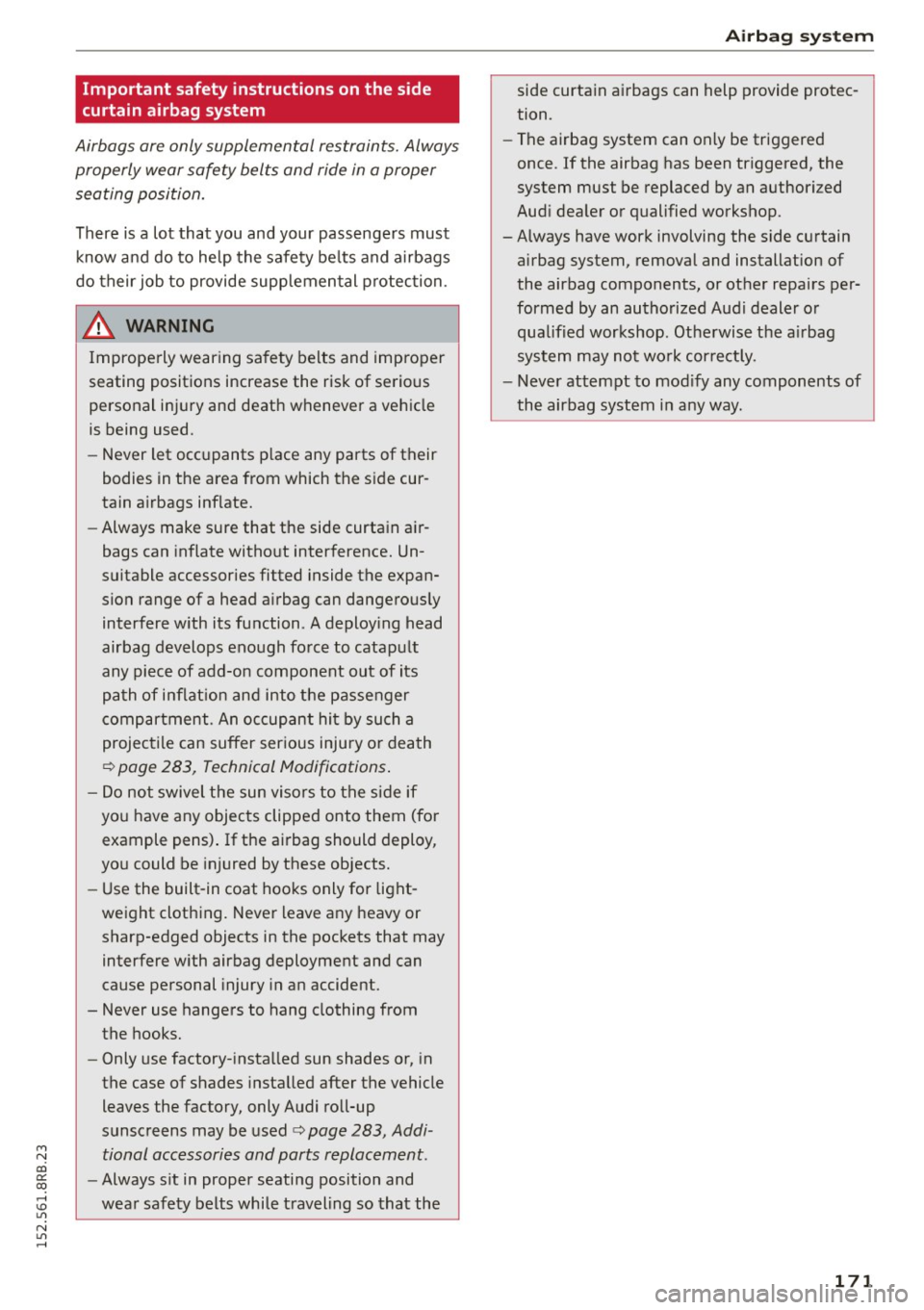
M N
co
a:
co
,...., \!) 1.1"1
N 1.1"1 ,....,
Important safety instructions on the side
curtain airbag system
Airbags are only supplemental restraints. Always
properly wear safety belts and ride in a proper
seating position.
There is a lot that you and your passengers must
know and do to help the safety belts and airbags
do their job to provide supplemental protection.
& WARNING
-
Improperly wearing safety belts and improper
seating positions increase the risk of serious
personal injury and death whenever a vehicle
is being used.
- Never let occupants place any parts of their
bodies in the area from which the side cur
tain airbags inflate.
- Always make sure that the side curtain air
bags can inflate without interference. Un
suitable accessories fitted inside the expan
sion range of a head airbag can dangerously
interfere with its function. A deploying head
airbag develops enough force to catapult
any piece of add-on component out of its
path of inflation and into the passenger
compartment. An occupant hit by such a
projectile can suffer serious injury or death
¢ page 283, Technical Modifications.
- Do not swivel the sun visors to the side if
you have any objects clipped onto them (for
example pens). If the airbag should deploy,
you could be injured by these objects.
- Use the built-in coat hooks only for light
weight clothing. Never leave any heavy or
sharp-edged objects in the pockets that may
interfere with airbag deployment and can
cause personal injury in an accident.
- Never use hangers to hang clothing from the hooks.
- Only use factory-installed sun shades or, in
the case of shades installed after the vehicle
leaves the factory, only Audi roll-up
sunscreens may be used
¢ page 283, Addi
tional accessories and parts replacement.
- Always sit in proper seating position and
wear safety belts while traveling so that the
Airbag system
side curtain airbags can help provide protec
tion.
- The airbag system can only be triggered
once. If the airbag has been triggered, the
system must be replaced by an authorized
Audi dealer or qualified workshop.
- Always have work involving the side curtain
airbag system, removal and installation of
the airbag components, or other repairs per
formed by an authorized Audi dealer or
qualified workshop. Otherwise the airbag
system may not work correctly.
- Never attempt to modify any components of
the airbag system in any way.
171
Page 174 of 302
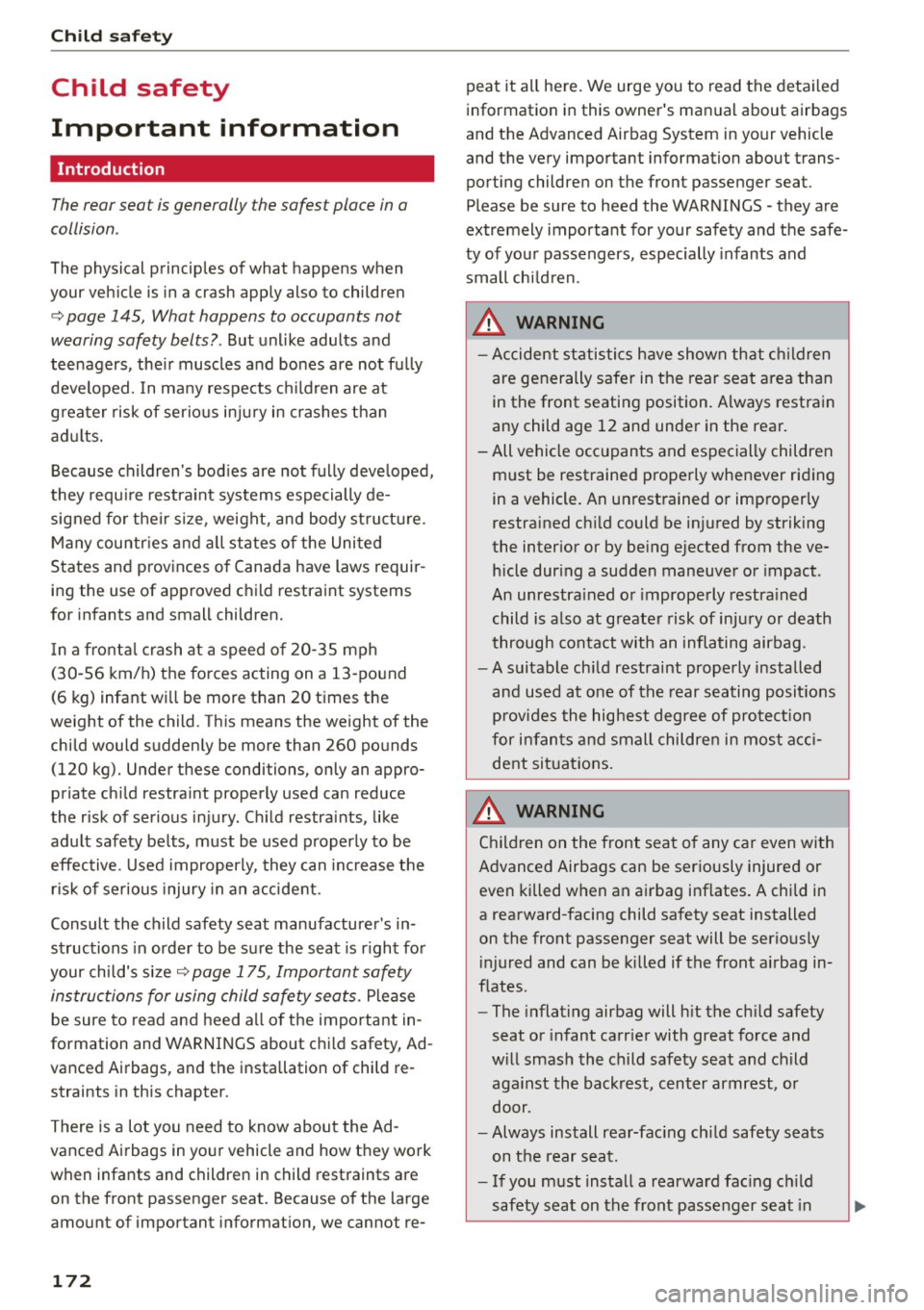
Child safety
Child safety
Important information
Introduction
The rear seat is generally the safest place in a
collision .
The physical principles of what happens when
your vehicle is in a crash apply also to children
¢ page 145, What happens to occupants not
wearing safety belts? .
But unlike adults and
teenagers, the ir muscles and bones are not fully
developed. In many respects children are at
g reater risk of serious injury in crashes than
adults.
Because children's bod ies are not fully deve loped,
they requ ire restra int systems especially de
signed for their size, weight, and body structure.
Many countr ies and all states of the United
States and provinces of Canada have laws requir
ing the use of approved c hild restraint systems
for infants and small children.
I n a fronta l crash at a speed of 20-35 mph
(30 -56 km/h) the forces acting on a 13 -pound
(6 kg) infant wi ll be more than 20 times the
weight of the child. This means the weight of the child would suddenly be more than 260 pounds
(120 kg). Under these conditions, only an appro
priate child restra int properly used can reduce
the r isk of serious injury . Ch ild restraints, like
adu lt safety be lts, must be used properly to be
effective. Used improperly, they can inc rease the
risk of serious injury in an accident.
Consult the child safety seat manufacturer's in
structions in order to be sure the seat is r ight for
your child's size¢
page 175, Important safety
instructions for using child safety seats .
Please
be sure to read and heed all of the important in
formation and WARNINGS about ch ild safety, Ad
vanced Airbags, and the installation of child re
straints in this chapter.
There is a lot you need to know about the Ad
vanced Airbags in your vehicle and how they work
when infants and children in child restraints are
on the front passenger seat. Because of the large
amount of important information, we cannot re-
172
peat it all here. We urge you to read the detailed
information in this owner's manua l about airbags
and the Advanced Airbag System in your vehicle and the very important information about trans
porting children on the front passenger seat.
Please be sure to heed the WARNINGS -they are
extremely important for your safety and the safe
ty of your passengers, especially infants and
small chi ld ren.
.&_ WARNING
- Accident statistics have shown that children
are generally safer in the rear seat area than
in the front seating position. Always restrain
any child age 12 and under in the rear.
- All vehicle occupants and especially children
m ust be restrained properly whenever riding
in a vehicle. An unrestrained or improperly restrained ch ild could be injured by striking
the inter ior or by be ing ejected from the ve
hicle dur ing a sudden maneuver or impact .
An unrestra ined or improperly restrained
child is a lso at greater risk of injury or death
through contact with an inflating airbag.
- A suitable ch ild restraint properly installed
and used at one of the rear seating posit ions
provides the highest degree of pro tect ion
for infants and small children in most acci
dent sit uations.
.&_ WARNING
Children on the front seat of any car even with
Advanced Airbags can be seriously injured or
even killed when an airbag inflates. A child in
a rearward-facing child safety seat installed
on the front passenger seat will be serious ly
injured and can be killed if the front airbag in
flates.
- The inflating airbag will h it the ch ild safety
seat or infant carr ier with great force and
w ill smash the child safety seat and child
aga inst the back rest, center armrest, or
door.
- Always install rear-fac ing ch ild safety seats
on the rear seat.
- If you must install a rearward fac ing ch ild
safety seat on the front passenger seat in
Page 175 of 302

M N
co
a:
co
,...., \!) ..,.,
N ..,., ,....,
exceptional circumstances and the
PASSENGER AIR BAG OFF light does not
come on and stay on, immediately install
the rear-facing child safety seat in a rear
seating position and have the airbag system
inspected immediately by your Audi dealer .
A WARNING
If, in exceptional circumstances, you must in
stall a forward-facing child restraint on the
front passenger's seat:
- Always make sure the forward-facing seat
has been designed and certified by its man
ufacturer for use on a front seat with a pas
senger front and side airbag.
- Always follow the manufacturer's instruc
tions provided with the child safety seat or
carrier.
- Always move the passenger seat into its
rearmost position in the seat's fore and aft
adjustment range, as far away from the air
bag as possible before installing the child
restraint. The backrest must be adjusted to
an upright position.
- Always make sure that the
PASSENGER AIR
BAG OFF
light comes on and stays on all the
time whenever the ignition is switched on.
(D Tips
Always replace child restraints that were in
stalled in a vehicle during a crash. Damage to
a child restraint that is not visible could cause
it to fail in another collision situation.
Advanced front airbag system and children
Your vehicle is equipped with a front "Advanced
Airbag System " in compliance with United States
Federal Motor Vehicle Safety Standard (FMVSS)
208 as applicable at the time your vehicle was
manufactured.
The Advanced Airbag system in your vehicle has
been certified to meet the "low-risk" require
ments for 3- and 6-year old children on the pas
senger side and small adults on the driver side.
The low risk deployment criteria are intended to
reduce the risk of injury through interaction with
Child safety
the airbag that can occur, for example, by being
too close to the steering wheel and instrument
panel when the airbag inflates. In addition, the
system has been certified to comply with the "suppression" requirements of the Safety Stand
ard, to turn off the front airbag for infants up to 12 months who are restrained on the front pas
senger seat in child restraints that are listed in
the Standard.
Even though your vehicle is equipped with an Ad
vanced Airbag system, all children, especially
those 12 years and younger, should always ride in
the back seat properly restrained for their age
and size . The airbag on the passenger side makes
the front seat a potentially dangerous place for a child to ride. The front seat is not the safest place
for a child in a forward-facing child safety seat. It can be a very dangerous place for an infant or a
larger child in a rearward-facing seat.
Advanced Airbags and the weight-sensing mat in the front seat
The Advanced Airbag System in your vehicle de
tects the presence of an infant or child in a child
restraint on the front passenger seat using the
weight-sensing mat in the seat cushion and the
sensor below the safety belt latch on the front
passenger seat that measures the tension on the
safety belt .
The weight-sensing mat measures total weight of
the child and the child safety seat and a child blanket on the front passenger seat. The weight
on the front passenger seat is related to the de
sign of the child restraint and its "footprint", the
size and shape of the bottom of the child re straint as it sits on the seat . The weight of a child
restraint and its "footprint" vary for different
kinds of child restraints and for the different
models of the same kind of child restraint offered
by child restraint manufacturers.
The weight ranges for the individual types, makes
and models of child restraints that the NHTSA
has specified in the Safety Standard together
with the weight ranges of typical infants and typ
ical 1 year-old child have been stored in the con
trol unit of the Advanced Airbag System. When a
1iJ11-
173
Page 176 of 302

Child safety
child restraint is being used on the front passen
ger seat with a typical 1 year-old child , the Ad
vanced Airbag System compares the weight
measured by the weight sensing mat with the in
formation stored in the electron ic control unit.
The electronic control unit a lso reg isters the ten
sion on the front passenger safety be lt. The ten
sion on the safety belt for the front passenger
seat will be d ifferent for an adult who is properly
using the safety belt as compared to the tens ion
on the belt when it is used to attach a child re
straint to the seat. The senso r below the latch fo r
the safety belt for the fron t seat passenge r
measures the tension on the be lt. T he inp ut from
t his sensor is then used w ith the weight to "de
cide", whether there is a c hild restraint with a
typical 1 year -old chi ld on the front passenge r
seat and whether or not the airbag must be
turned off .
Child restraints and Advanced Airbags
Regardless of the child restraint that you use,
make sure that it has been certified to meet Un it
ed States Federal Motor Vehicle Safety Standards
and has been ce rtified by i ts manufact urer for
use with an airbag . A lways be sure tha t the child
restrain t is properly ins talled at one of the re ar
seating posi tions . If in exceptiona l circumstances
you must use it on the front passenger seat, care
fu lly read all of the informat ion on child safety
and Advanced Airbags and heed a ll of the appli
cable WARNINGS . Make certain that the ch ild re
straint is correctly recognized by the weight -sens
i n g mat inside the front passenger seat, that the
front pass enge r airbag is turned off and that the
a ir bag s tatus is a lways corre ctly s ignaled by t he
PASSENGER AIR BAG OFF li ght.
Many types and models of ch ild restra ints have
been ava ila ble over the y ears, new models are in
troduced regu larly i ncorpo rat ing new and im
p rove d des igns and o lde r models a re t aken o ut o f
p rod uction. Child rest rain ts a re not standardized .
C hild restraints of the same type typically have
diffe rent weights and sizes and different 'foot
prints,' the size and shape of the bottom of the
child restraint that sits on the seat, w hen they
are i nstalled on a veh icle seat. These differences
174 make
it virtua lly impossib le to cert ify compliance
with t he requirements for advanced airbags with
each and every chi ld restraint that has ever been
so ld in the past or will be sold over the course of
the usefu l life of your vehicle.
Fo r th is reason, the Unite d States National High
way T raffic Safety Adm inistrat ion has published a
li st of specific type, makes and models of child
rest raints that must be used to cert ify compli
ance of the Advanced Airbag System in your veh i
cle w ith the s uppression requi rements of Federal
Motor Veh icle Safety S tanda rd 208. These child
r est raints a re:
Subpart A -Car bed child restraints
Model Manufactured on or
after
A ngel Guard Angel September 2S , 2007
R id e AA 2403FOF
Subpart B - Rear-facing child restraints
Model Manufactured on or
after
Century Smart Fit 4 54 3 December 1, 1999
Cosco Arriva September 25, 2007
22 -013PAW and base
22-999WHO
Evenflo Discove ry Ad- December 1, 1999
just R ight 212
E venflo First Choi ce Decembe r 1, 1999
2 04
Graco Infant 8457 December 1, 1999
Gr aco S nugride Se pte mber 25 , 20 07
Peg Perego Pr imo Viag- September 25, 2007
gio SIP IM UNOOUS
Subpart C - Forward-facing and convertible
child restraints
Model Manufactured on or
after
B rit a x Round about Septe mber 25, 200 7
E 9 L02xx
Cosco Tou riva 02519 December 1, 1999
Page 177 of 302
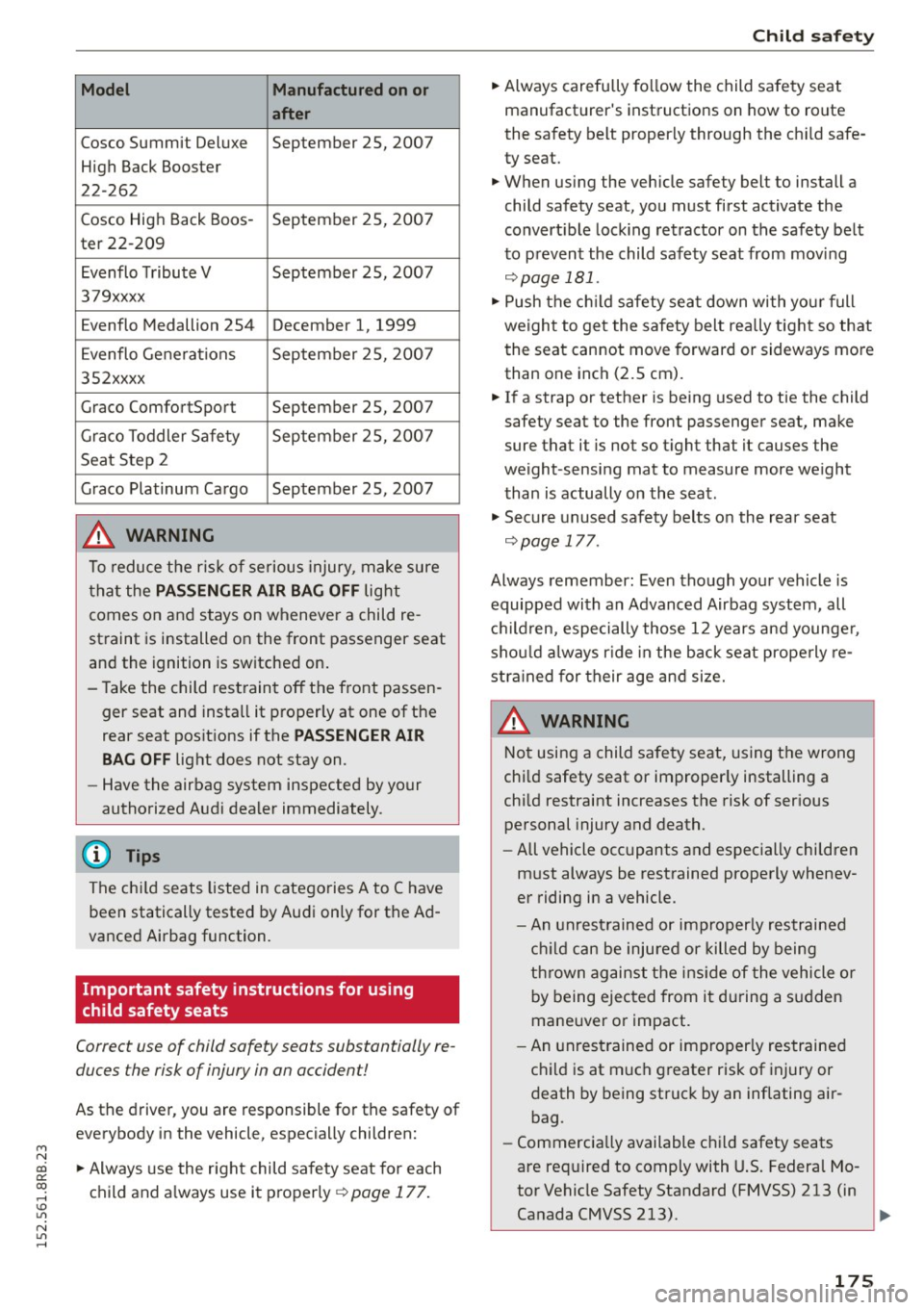
M N
co
a:
co
,...., \!) 1.1'1
N 1.1'1 ,....,
Model Manufactured on or
a fter
Cosco Summit Deluxe September 25, 2007
High Back Booster
22-262
Cosco High Back Boos -September 25, 2007
ter 22-209
Evenflo Tribute V September 25, 2007
379xxxx
Evenflo Medallion 254 December 1, 1999
Evenflo Generations September 25, 2007
3S2xxxx
Graco ComfortSport September 25, 2007
Graco Toddler Safety September 25, 2007
Seat Step 2
Graco Platinum Cargo September 25, 2007
.&, WARNING
To reduce the risk of serious injury, make sure
that the
PASS ENGER AIR BAG OFF light
comes on and stays on whenever a child re
straint is installed on the front passenger seat
and the ignition is switched on.
- Take the child restraint off the front passen ger seat and install it properly at one of the
rear seat positions if the
PASSENGER AIR
BA G OFF
light does not stay on.
- Have the airbag system inspected by your
authorized Audi dealer immediately.
(D Tips
The ch ild seats listed in categories A to C have
been statically tested by Audi on ly for the Ad
vanced Airbag function.
Important safety instructions for using
child safety seats
Correct use of child safety seats substantially re
duces the risk of injury in an accident!
As the driver, you are responsible for the safety of
everybody in the vehicle, especially children:
.,. Always use the right child safe ty seat for each
child and a lways use it properly ¢
page 177.
Child sa fety
.,. Always carefully follow the child safety seat
manufacturer's instructio ns on how to route
the safety belt properly through the child safe
ty seat.
.,. When using the vehicle safety belt to install a
child safety seat, you must first activate the
convert ible lock ing retractor on the safety belt
to prevent the child safety seat from mov ing
r::) page 181 .
.,. Push the ch ild safety sea t down with yo ur full
weight to get the safety belt rea lly tight so that
the seat cannot move forward or sideways more
than one inch (2.5 cm).
.,. If a strap or tether is being used to tie the child
safety seat to the front passenger seat, make
sure that it is not so tight that it causes the
weight -sensing mat to measure more we ight
than is actually on the seat .
.,. Secure unused safety belts on the rear seat
r::) page 177 .
Always remember : Even though your vehicle is
equipped with an Advanced Airbag system, all
c hi ld ren, especially those 12 years and younge r,
shou ld a lways r ide in the back seat prope rly re
stra ined for their age and size.
A WARNING
=
Not using a child sa fety seat, us ing the wrong
chi ld safety seat or improperly installing a
chi ld restraint increases the risk of serious
personal injury and death.
- All vehicle occ upants and especially children
must always be restrained properly whenev
er riding in a vehicle .
- An unrest rained or improperly restrained
ch ild can be injured or killed by being
thrown against the ins ide of the vehicle o r
b y being ejected from it du ring a s udden
maneuver or impact.
- An unrestrained or improperly res trained
child is at much greater risk of injury or
death by being struck by an inflating air
bag.
- Commercia lly available child safety seats
are req uired to comply with U.S. Federa l Mo
tor Vehicle Safety Standard (FMVSS) 213 (in
Canada CMVSS 213). .,_
175
Page 178 of 302
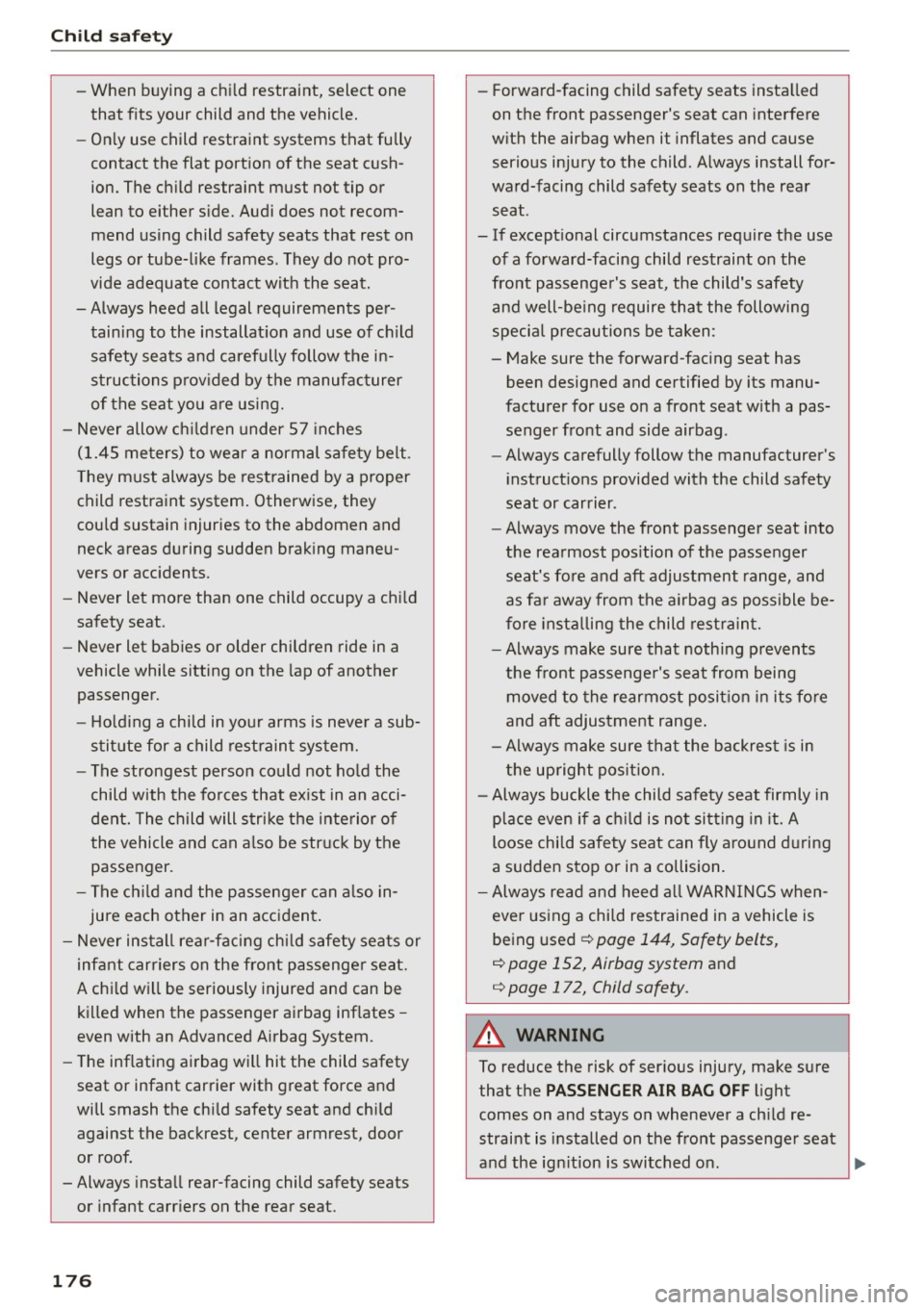
Child safet y
-When b uying a ch ild restraint, select one
that fits your child and the vehicle.
- On ly use child restraint systems that fully
contact the flat port ion of the seat cush
ion. The ch ild restra int must not tip or
lean to either s ide. Audi does not recom
mend using child safety seats that rest on
legs o r tube-like frames . They do not pro
vide adequate contact with the seat.
- Always heed all legal requirements pe r
taining to the installat ion and use of ch ild
safety seats and carefully follow the in
struc tions prov ided by the manufacturer
of the seat you are using.
- Never allow ch ildren under 57 inches
(1.45 me ters) to wear a normal sa fety belt .
They m ust always be rest rained by a proper
child restra int system. Otherwise, they
could sustain injuries to the abdomen and
neck areas during sudden braking maneu
vers or acc idents.
- Never let more than one child occupy a chi ld
safety seat.
- Never let babies or older children ride in a
vehicle while sitting on the lap of another
passenger.
- Ho ld ing a child in your arms is neve r a sub
stit ute for a child rest raint sys tem.
- The strongest person co uld not hold the
child with the fo rces that ex ist in an acci
dent. The child will s tri ke the inte rior of
the vehicle and can a lso be str uck by the
passenger.
- The ch ild and the passenger can a lso in
jure each other in an acc ident .
- Never ins tall rear-facing chi ld safety seats or
infant carriers on the front passenger seat.
A ch ild w ill be seriously injured and can be
killed when the passenger airbag inf lates -
even with an Advanced Airbag System .
- The inf lating airbag will hit the child safety
seat or infant carrier with great force and
will smash the chi ld safety seat and child
against the backrest, center armrest, door
o r roof.
-Always insta ll rear-facing child safety seats
or infant carr iers on the rear seat.
176
- Forwa rd-facing child safety seats insta lled
on the front passenger's seat can interfere
w ith the airbag when it inflates and cause
serious injury to the child. Always install fo r
ward-facing child safety seats on the rear seat .
- If except ional circumstances require the use
of a fo rward-facing child restraint on the
front passenge r's seat, the child's safety
and well-be ing require that the following
speci al precautions be taken :
- Make sure the forward-facing seat has
been designed and certified by its manu
factu rer for use on a front seat w ith a pas
senger front and side airbag .
- Always carefully follow the manufacturer's
i nst ructions provided with the child safety
seat or carrier .
- Always move the front passenger seat into
the rea rmost pos ition of the passenger
seat's fore and aft adjustment range, and
as fa r away from the a irbag as poss ible be
fo re insta lling the child rest raint.
- Always make sure that nothing p revents
the front passenge r's seat from being
moved to the rearmost posit ion in its fo re
and aft adjustment range .
- Always make sure tha t the backres t is in
the up right pos ition.
- Always buckle the child sa fety seat firmly in
place even if a ch ild is not si tting in it. A
loose child safety seat can fly around d uring
a sudden stop or in a collision.
- Always read and heed a ll WARNI NGS when
eve r us ing a child restrained in a vehicle is
be ing used
¢ page 144, Safety belts,
¢ page 152, Airbag system and
¢ page 172 , Child safety.
A WARNING
To reduce the risk of ser ious injury, make sure
that the
PASSENGER AIR BAG OFF li ght
comes on and stays on whenever a ch ild re
straint is installed on the front passenge r seat
and the ign ition is switched on . ..,.
Page 179 of 302
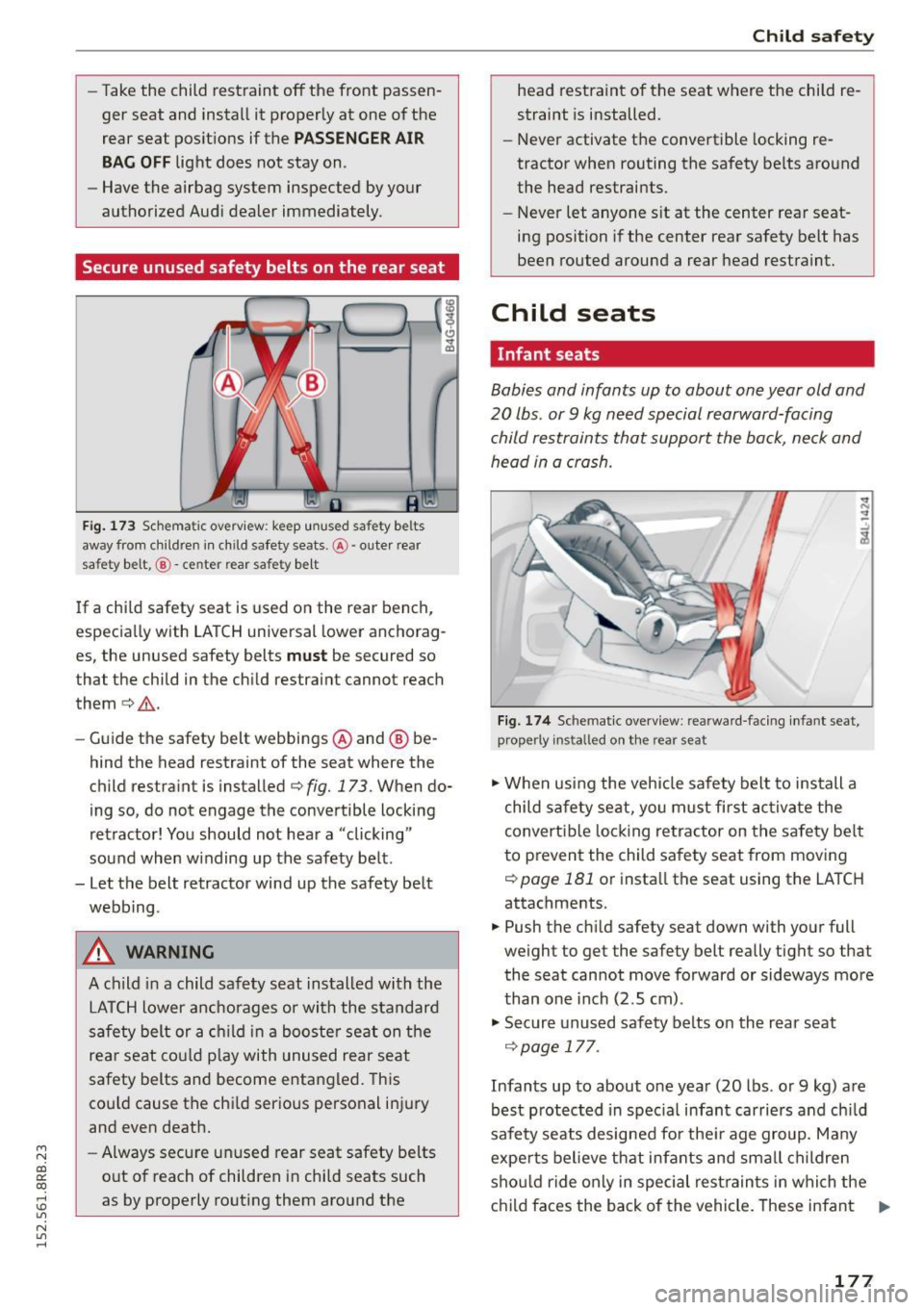
M N
co ~ co
rl I.O
"' N
"' rl
-Take the child restraint off the front passen
ger seat and install it properly at one of the
rear seat pos itions if the
PASSENGER AIR
BA G OFF
light does not stay on.
- Have the airbag system inspected by your
authorized Audi dealer immediately.
Secure unused safety belts on the rear seat
Fig . 173 Schematic overview: keep unused safety belts
away from children in child safety seats. @-oute r rear
safety belt,
@ -center rea r safety belt
If a chi ld safety seat is used on the rear bench ,
especia lly with LATCH universal lower anchorag
es, the unused safety belts
must be secured so
that the child in the child restraint cannot reach
them¢ _&.
- Guide the safety belt webbings @and @ be
hind the head restraint of the seat where the
child restraint is installed¢
fig. 173. When do
ing so, do not engage the convertible locking
retractor! You should not hear a "clicking"
sound when w inding up the safety belt.
- Let the belt retractor wind up the safety belt
webbing .
A WARNING
A child in a child safety seat installed with the
LA TCH lower anchorages or with the standard
safety belt or a ch ild i n a booste r seat on the
rea r seat co uld play with unused rear seat
safety belts and become entangled. This
co uld cause the chi ld serious personal inj ury
and even death.
- Always secure un used rear seat safety belts
o ut of reach of children in child seats such
as by properly routing them around the
Chil d sa fe ty
head restra int of the seat where the child re
straint is installed.
- Never activate the convertible locking re
tractor when routing the safety belts around
the head restraints.
- Never let anyone s it at the center rear seat
ing position if the center rear safety belt has
been routed around a rear head restraint.
Child seats
Infant seats
Babies and infants up to about one year old and
20 lbs . or
9 kg need special rearward-facing
child restraints that support the back, neck and
head in a crash.
F ig. 174 Schemat ic overv iew : rearward -fac ing infant seat,
proper ly installed on th e rear seat
., W hen using the vehicle safety belt to install a
child safe ty seat, yo u must first ac tivate the
convert ib le lock ing retractor on the safety be lt
to prevent the child sa fety seat from mov ing
i=:> page 181 or insta ll the seat using the LATCH
attachments.
.. Push the child safety seat down with your full
weight to get the safety belt really tight so that
the seat cannot move forward or sideways more
than one inch (2.5 cm).
., Secure unused safety belts on the rear seat
¢page 177.
Infants up to about one year (20 lbs. or 9 kg) are
best p rotected in spec ial infant carriers and ch ild
safety seats designed for the ir age group. Many
expe rts bel ieve that infants and sma ll children
sho uld ride only in special restrain ts in which the
child faces the back of the vehicle. These infant .,.
177
Page 180 of 302
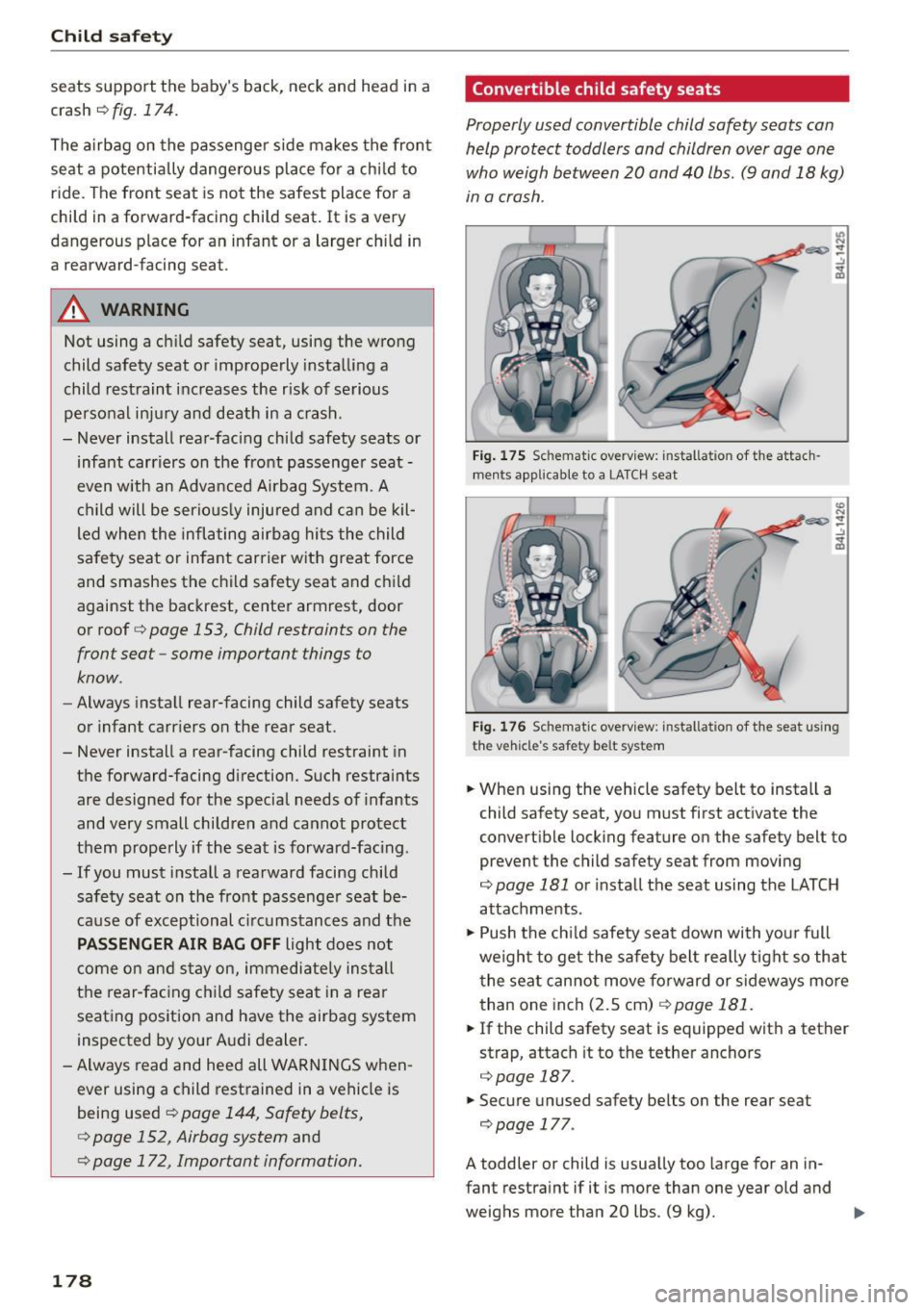
Child safety
seats support t he baby 's back, neck and head in a
crash
r=> fig . 174.
The airbag on the passenger side makes the fron t
seat a potentially dange rous place for a ch ild to
ride. The front seat is not the safest place for a
child in a fo rward-facing child seat. It is a very
dangerous p lace for an infant or a larger chi ld in
a rearward-facing seat .
_&. WARNING
Not using a child safety seat , using the wrong
child safety seat o r imp roperly insta lling a
child restraint inc reases the r isk of serious
personal in ju ry and death in a crash .
- Never install rea r-facing ch ild safety seats or
infant carriers on the front passenger seat -
even w ith an Advanced Ai rbag System. A
c hild will be serio us ly injured and c an be kil
led whe n the infl ating airbag hits the child
sa fe ty seat or infant carrier w ith great force
and smashes the c hild safety seat and c hild
against the bac krest, center armrest, door
or roof
r=> page 153, Child restraints on the
front seat -some important things to
know .
-Always insta ll rear-facing child safety seats
o r infant ca rr iers on the rear seat.
- Never install a rear-facing child restraint in the forward-facing direction. Such restra ints
are designed for the specia l needs of infants
and very small children and cannot protect
them prope rly if the seat is forward-fac ing .
- If you must install a rearward facing child safety seat on the front pass enge r seat be
ca use of exceptional c ircumstanc es and t he
PASSENGER AIR BAG OFF light does not
c ome on an d st ay on, immedi ate ly ins tall
t h e rear-facing c hild safety sea t in a rea r
seat ing position and have the airbag system
inspected by your Audi dealer.
- Alw ays read and hee d all WARN INGS when
ever using a child restrained in a vehicle is
being used
c::> page 144 , Safety belts,
c::> page 152, Airbag system
and
c::> page 172, Important information.
178
Convertible child safety seats
Properly used convertible child safety seats can
help protect toddlers and children over age one
who weigh between 20 and 40 lbs. (9 and 18 kg)
in a cra sh .
Fi g. 175 Sc hem at ic ove rv iew: instal la ti on of t he attach
m ents applicable to a LA T CH seat
Fi g. 1 76 Schemat ic ove rv iew : in stal lat io n of th e seat usin g
the v ehicl e's sa fet y bel t system
.. When using the vehicle safety belt to install a
child sa fety seat, you must first activate the
convertible locking feature on the safety belt to
prevent the child safety seat from moving
r=> page 181 or i nsta ll the seat using the LATC H
attachments.
.,. Push the ch ild safety seat down with you r full
weigh t to get the safe ty belt rea lly tight so that
t he sea t ca nnot move forward or sideways mo re
than one inch (2.5 cm)
r=> page 181.
.. If the child safety seat is equipped with a tether
strap, attach it to the tether anchors
c::> page 187.
.. Secure unused safety belts on the rear seat
r=> page 177 .
A toddler or child is usua lly too large for an in
fant restra int if it is more than one year old and
weighs more than 20 lbs . (9 kg) .
IJJ,,